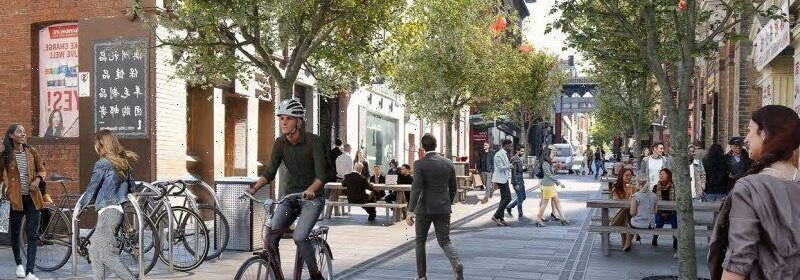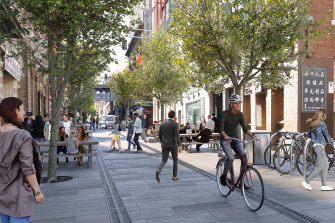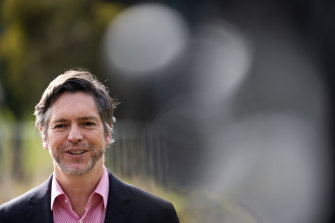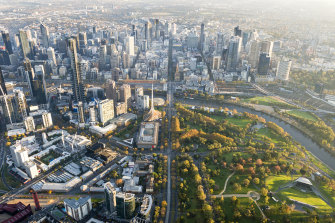Go west: Council unveils 20-year plan for inner Melbourne

Key points
- The Municipal Planning Strategy forecasts 79 per cent population growth, or about 144,000 people, many of whom will live in developed former industrial areas and the Hoddle Grid.
- The City of Melbourne also wants 1.4 million people working, visiting and moving around the city on any given day by 2040 – a number which sat at 972,000 pre-pandemic.
- The council’s vision is for a greener and more sustainable city with zero net emissions by 2030 and zero net waste by 2040.
The inner Melbourne of the future will be bigger, denser and greener as western parts of the city become the new Fitzroy and Collingwood and pedestrians and bikes are increasingly prioritised over cars.
A 20-year blueprint to be published by the City of Melbourne on Saturday lays out a vision for the growth of the municipality.
An artist’s render of the gutterless streets planned for Melbourne’s Chinatown and other “little streets” to encourage pedestrians and bikes. Credit:City of Melbourne
The plan names the key areas expected to undergo the most dramatic residential change over the next two decades as Macaulay and Arden, nestled between North Melbourne and Kensington, as well as Fishermans Bend and Lorimer, south of the Yarra.
“The growth of the municipality is now moving west, onto the lower, wetter plains,” it says.
Shift to the west
Acting Lord Mayor Nicholas Reece said the blueprint was the most extensive plan for the city since the 1990s. The “transformative vision” set out in the Municipal Planning Strategy and City Spatial Plan envisaged new suburbs to the west and to the north of the Hoddle Grid, he said.
Acting Lord Mayor Nicholas Reece said the plan would be transformative for the west and north-west of inner Melbourne.Credit:Jason South
“These are the biggest urban renewal projects in Australia and they will be transformative for the west and north-west of inner Melbourne. The plans are for a new vision for the transformation of West Melbourne into the next Fitzroy or Collingwood as a mixed-use area that is respectful of the industrial heritage of the area.”
Reece said the council envisaged Arden and Macaulay developing as mid-rise residential and office areas.
“We see them becoming the Barcelona of the south in terms of the sort of built form and streets that we’re looking for.”
Fishermans Bend does not have any residents at the moment but by 2040 the City of Melbourne forecasts 21,089 people will live in the area.
West Melbourne and the area next to North Melbourne dubbed City North will continue to experience “infill” development as old industrial buildings are converted to apartments, stores and offices, while the report has flagged renewal of E-Gate, Dynon and the Maribyrnong waterfront into more open space and “industrial areas that support the knowledge economy”.
The city says West Melbourne alone will need 6700 more homes.
The Municipal Planning Strategy is to go before the City of Melbourne’s Future Melbourne committee on Tuesday. The council will then request authorisation from the planning minister to amend the Melbourne Planning Scheme to include the strategy. The state government does not sign off on the City Spatial Plan.
Associate Professor Andrew Butt, of RMIT’s Centre for Urban Research, said the reasons for “reusing” former industrial areas to the west of the city were obvious.
“From an overall perspective of metropolitan Melbourne planning, inner and middle Melbourne still needs to do much more of the heavy lifting of growth if we’re going to prevent the sorts of sprawling and poorly serviced neighbourhoods we’re seeing on the fringe of Melbourne,” he said.
“[But] it’s politically challenging to try and grow into any heritage areas like Carlton, North Melbourne or East Melbourne.”
While he welcomed the focus on areas such as Arden and Macaulay, he said the city needed to ensure it had learnt lessons from the redevelopment of industrial areas in the past.
“The lessons from Docklands [for example] is simply parceling land out to different developers to work with really doesn’t end up with a comprehensive idea of [a suburb]. So we’ve ended up in Docklands where it took close to 20 years to build a school.”
Butt said Melbourne City Council had been given an opportunity in the fallout of the pandemic to create more considered development in the renewal areas where housing could be built for larger families and retirees and where buildings had mixed uses, rather than being solely office buildings.
Prioritising pedestrians and bikes
Despite the drop-off in public transport use during and after lockdowns, the council is pushing ahead with a vision of far fewer cars in the city, listing car dominance as one if its key challenges.
An aerial view of Melbourne.Credit:iStock
Reece said introducing gutterless roads along the “little” streets and laneways of Melbourne, such as Flinders Lane and Little Bourke, Little Collins and Little Lonsdale streets, would be one way to discourage cars.
Cars would still be allowed in the streets but removing gutters would encourage more pedestrians and bikes, he said.
“They have a positive, traffic calming effect; it does tend to slow everyone down,” he said. “Cities like Rome, Milan, Paris, London, you’re really seeing this rollout of these gutterless streets.”
The City of Melbourne wants to redress the imbalance in the Hoddle Grid, where 60 per cent of street space is allocated to vehicles despite private cars accounting for only a third of all trips.
Butt welcomed the gutter removals and said Melbourne’s “little streets” were “much more valuable to us as places to be and inhabit than they are as places to drive through”.
But he said it would take an intervention from the state government to drastically reduce car traffic in the CBD and stop roads such as Spencer Street, King Street, Flinders Street and Exhibition Street being used as thoroughfares for drivers to cross town.
“With the new West Gate Tunnel, for example, the state government needs to be serious about the fact that it should divert traffic [out of the city centre], and they should assist that traffic to be diverted.”
The plan also outlines a new tram route from Fishermans Bend and Spencer Street to West Melbourne.
A rising population
Despite the setbacks of the pandemic, the Municipal Planning Strategy forecasts 79 per cent population growth – or about 144,000 people – many of whom will live in developed former industrial areas and the Hoddle Grid.
The City of Melbourne wants 1.4 million people working, visiting and moving around the city on any given day by 2040. The number sat at 972,000 before the pandemic.
The council forecasts the number of residents living in the Hoddle Grid will more or less double to about 100,000, while the number of workers will grow from 211,000 in 2020 to 310,000 in 2040.
Reece said the pandemic had not changed the long-term trajectory for Melbourne’s growth.
“In many ways, the things that made Melbourne so attractive to immigrants from interstate and internationally before COVID will be even more so post-COVID,” he said.
Listed among the city’s other big challenges are poorly designed buildings, buildings not designed to withstand increasingly extreme weather as a result of climate change, the need to bring back international students and thwarting high rates of loneliness and isolation for more than half of the population who live alone.
A greener city
The council’s vision is also for a greener and more sustainable city with zero net emissions by 2030 and zero net waste by 2040.
“We will achieve zero net emissions by rewiring and electrifying the city and moving the entire municipality over to renewable power,” Reece said. “We’ll achieve zero waste by stepping up our waste management and recycling programs and introducing comprehensive lifecycle programs around waste.”
The Morning Edition newsletter is our guide to the day’s most important and interesting stories, analysis and insights. Sign up here.
Most Viewed in National
From our partners
Source: Read Full Article


